Greetings from afar: Celebrating Christmas on board
GEOMAR researchers spend the festive season in the service of science at sea
They are investigating the ephemerality of the East Antarctic Ice Sheet, determining trace gases in the Labrador Sea, exploring a newly discovered groundwater source under the seafloor, or creating a seismic image of the fault system at the mid-ocean ridge east of Madagascar: four groups of scientists from the GEOMAR Helmholtz Centre for Ocean Research Kiel are currently on expeditions with the research vessels POLARSTERN (PS140), METEOR (M196), MARIA S. MERIAN (MSM123) and SONNE (SO301) on expeditions across the world's ocean. This year they are spending the Christmas holidays at sea - away from their families and loved ones, because science knows no holidays.
"Some may find it easier, because as seafarers they are perhaps used to being away from home for long periods, or even feel at home on board," says Julia Schätzel, team assistant in the Marine Geodynamics Research Unit and currently on board METEOR, "but many will certainly not have an easy time. They sleep to the clock, always with an eye on the next shift. The crew can never really relax during an expedition: being able to react to the unexpected in an emergency is part of the job and vital for survival.
This makes it all the more important to make the holidays as festive as possible, and there will be something special on board each research vessel. This is especially true of the food. While the food on board is generally good and plentiful - a prerequisite for keeping spirits up - the galleys work extra magic during the festive season.
M196: Decorating the Christmas tree in T-shirt weather
"It's Christmas on board," reports Julia Schätzel from the RV METEOR. Since the beginning of December, the research vessel has been in the Gulf of Corinth, Greece, for expedition M196, led by Dr Marion Jegen-Kulscar, to investigate a newly discovered groundwater reservoir beneath the seafloor. The mess hall, where the crew take their meals, is festively decorated for Christmas. Special festive meals are served on Advent Sundays, and the scientists have created an Advent calendar for themselves and the ship's crew.
Just before the holidays, the ship was noticeably emptier: on Friday, most of the participants disembarked in the port of Patras to spend Christmas at home. For the current transit to Cyprus, only the ship's crew and three GEOMAR employees - Julia Schätzel, Dr Marion Jegen-Kulscar and technician Martin Wollatz-Vogt - remain on board.
A Christmas tree was brought on board in Patras and will now be decorated together. The Christmas Eve meal will be simple, "in the spirit of potato salad and sausages". Afterwards, there will be gift-giving, but the presents will not be too serious. Julia Schätzel explains: "We do a kind of gag gift exchange and give each other things that have been lying around in the cabins for a long time. A special meal is planned for the first Christmas day: A roast pig barbecue on deck. The weather should be fine, with temperatures around 15 degrees Celsius and sunshine. The second day of Christmas will be truly festive. Schätzel says: "We are expecting a big Christmas dinner, very traditional with duck breast, red cabbage and everything that goes with it. She is grateful that the METEOR crew is putting so much effort into the preparations: "You have to remember: Every person at sea means an empty place under the Christmas tree on land. But if I can't be at home, I'm here in the second-best place and feel very well looked after".
MSM123: Baking cookies in rough seas
While we in Kiel can only dream of a white Christmas this year, there is no shortage of snow on the MARIA S. MERIAN. "It's definitely nice and cold here," says Dr Christa Marandino, "sometimes nice, sometimes very stormy". Expedition MSM123, led by the marine chemist, has been underway since the end of November in the Northwest Atlantic, specifically in the Labrador Sea between Canada and Greenland. Temperatures range from 2 to -5 degrees Celsius, and about once a week there is a storm with wind gusts well above 30 m/s and individual waves as high at 15 metres.
It's cozier below deck. The mess hall is decorated for Christmas, there was a visit from Nikolaus, and each Advent Sunday was celebrated with special food and gingerbread. They even baked their own cookies on board. The GC/MS lab is illuminated by fairy lights and a glowing star. "This is where we measure trace gases in the ocean," explains Dr Marandino. GC is the gas chromatography device used to separate the mixture under investigation, and MS is the mass spectrometer used to identify the individual components. The expedition is investigating how bubbles in the water affect the exchange of gases such as carbon dioxide and oxygen between the ocean and the air.
And what will they be eating for Christmas? That will be a surprise. Dr Marandino says: "I think that's one of the nice things - a surprise feast on board. The MERIAN crew is already in a festive mood and I'm sure we'll celebrate this day with a special meal".
SO301: Secret Santa in the science team
On the SO301 expedition, a small team of "OBS fishers" from GEOMAR is currently sailing in the Indian Ocean. OBS stands for Ocean Bottom Seismometers, developed by the Marine Geodynamics Research Unit at GEOMAR, which are used to measure the structure of the Earth's crust and mantle under the sea. "During the Christmas period, we will mainly be mapping the seafloor while the bottom seismometers record earthquakes from the three ridges," says Dr Anke Dannowski. "The weather has been favourable for us over the last few weeks and the seas are expected to be calm during the holidays. These are ideal conditions not only for measurements, but also for a Secret Santa exchange in the science team, for which everyone has brought a small gift on the cruise (or crafted one on board). "On Christmas Eve, the traditional sausages and potato salad will be on the buffet in the mess hall," says the geophysicist. Afterwards, there will be a small cultural programme: the captain will give a Christmas speech and the participants will present Christmas customs from their home countries. A festive meal with Christmas music is planned for the first day. Dr Dannowski adds: "The menu includes goose leg with red cabbage and potato dumplings. A short break before continuing with the tightly scheduled research programme.
PS140: Christmas carols in a fantastic iceberg landscape
From the icy landscape of the Antarctic Prydz Bay, the crew of the EASI-2 expedition (PS140) aboard the research vessel POLARSTERN send Christmas greetings home. "Upon arrival, we were greeted by penguins, seals, humpback whales and Australian colleagues", says Dr Marcus Gutjahr, geochemist at GEOMAR and leader of the expedition to East Antarctica. It is polar day in Antarctica. Gutjahr says: "There is hardly a cloud in the sky, and on the horizon we can see the Antarctic ice sheet and some icebergs in front of it. The scenery is fantastic and the mood is excellent.
On board POLARSTERN, the team will continue to work over the holidays as well. Over the coming weeks, the scientists will be investigating the current and past environmental conditions of this unique and pristine landscape. However, there is a festive atmosphere on board, complete with Christmas decorations and various Christmas trees. Some team members have even rehearsed Christmas carols together. Gutjahr says: "We have a nice surprise programme planned for Christmas Eve, we intend to stop at an ice floe and in the afternoon and evening we celebrate with a cosy festive dinner, mulled wine and Secret Santa. Presents are already prepared. And: The satellite connection back home is surprisingly stable; you can even try a video call if the homesickness gets too much. “We are very curious how many parallel calls our internet connection can take before it collapses. Hopefully many.”
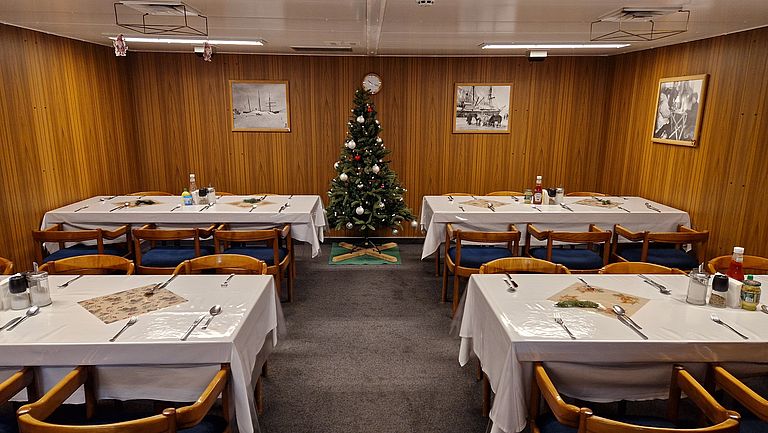
Colourfully decorated Christmas trees in the common areas bring a touch of festive atmosphere aboard the POLARSTERN. Photo: Marcus Gutjahr, GEOMAR
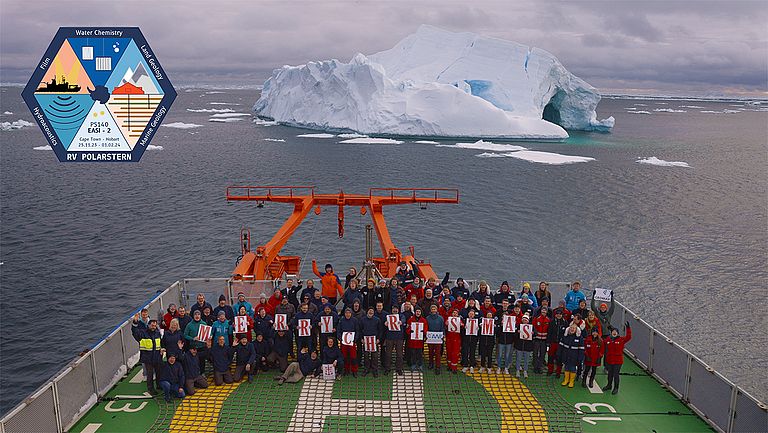
Greetings to Home: The team of POLARSTERN Expedition EASI-2 (PS140) wishes Merry Christmas! Photo: Ines Reinisch

Upon their arrival in the Antarctic Prydz Bay, the participants of Expedition PS140 were greeted by penguins. Photo: Marcus Gutjahr, GEOMAR.
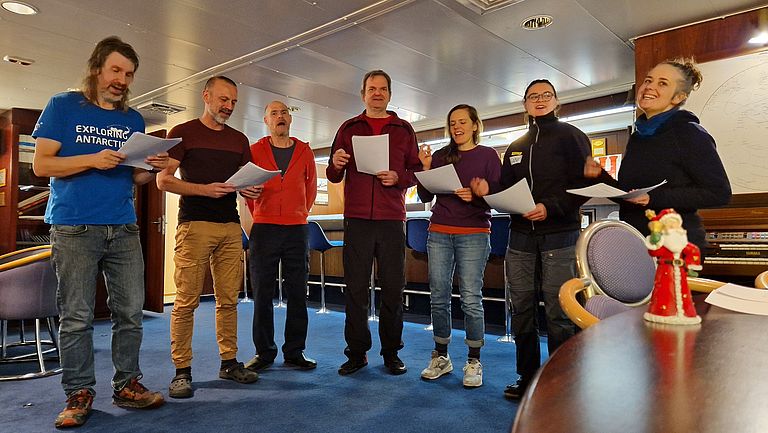
Small choir on board the POLARSTERN: Some team members have rehearsed Christmas carols together. Photo: Marcus Gutjahr, GEOMAR
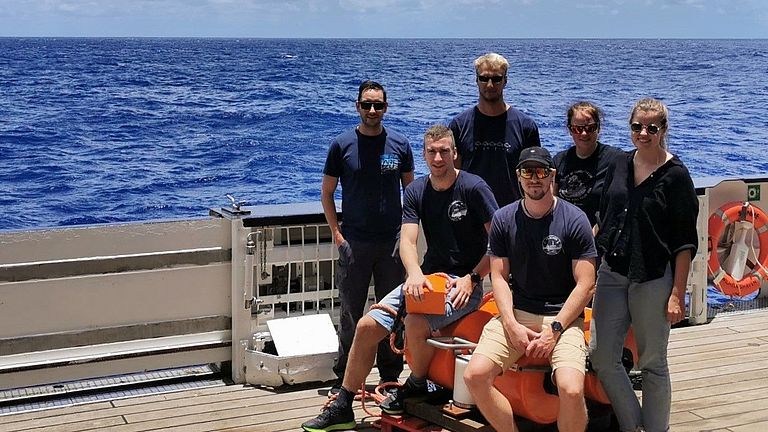
Perfect weather for measurements and a little Secret Santa gathering: A GEOMAR team is currently on the SO301 expedition in the Indian Ocean. Photo: Henri Renzelmann.
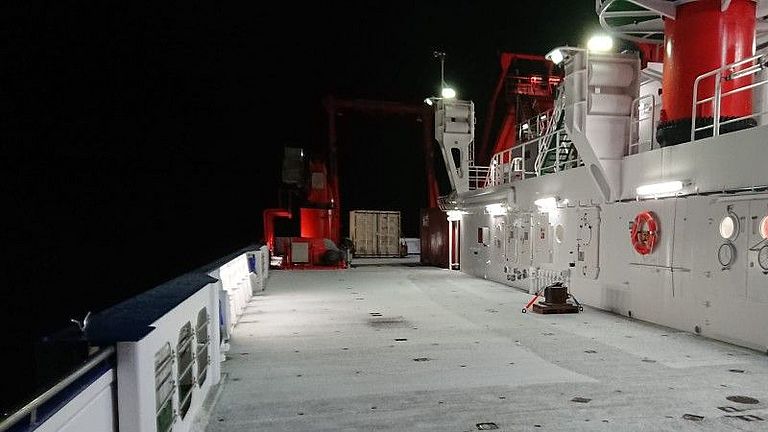
"Definitely nice and cold here!": The MSM123 expedition has been underway in the Northwest Atlantic between Canada and Greenland since the end of November. Photo: Christa Marandino, GEOMAR
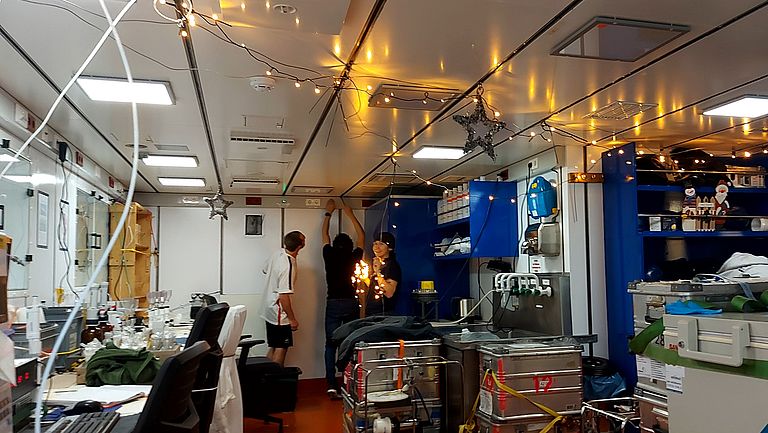
During the stormy weather in the Labrador Sea, the labs on board the MARIA S. MERIAN are being festively decorated. Photo: Christa Marandino, GEOMAR
![[Translate to English:] [Translate to English:] Eine Gruppe Menschen in Winterkleidung an Deck eines Schiffes](/fileadmin/_processed_/8/2/csm_BELS-team_-_1_-_3000x2000_bdd2b4a3a5.jpg)
![[Translate to English:] Two women and one man stand aboard a ship in front of the silhouette of a rocky coastline.](/fileadmin/_processed_/0/7/csm_M196_c_Hannes-Schuler_6c00bd31e3.jpg)
The METEOR in the Gulf of Corinth just before the holidays: For the final stretch to Cyprus, only Julia Schätzel, Dr. Marion Jegen-Kulscar, and technician Martin Wollatz-Vogt from GEOMAR have remained on board. Photo: Hannes Schuler


